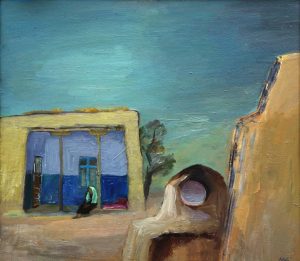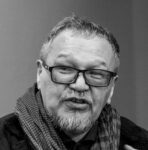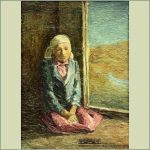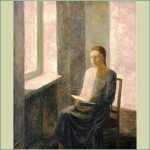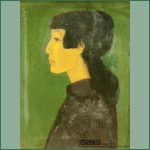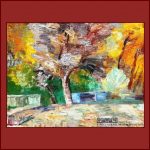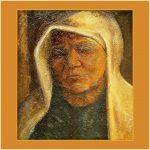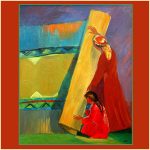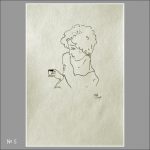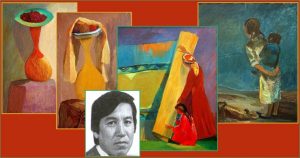
We continue to acquaint you with the work of Kyrgyz artists, presented in the collection of the National Museum, through the eyes of art critic GAMAL BOKONBAYEV. This is the first section of two devoted to the work of Aman Asrankulov.
Asrankulov Aman (1939-1998) is a painter. Born in the city of Frunze (Bishkek). In 1964 he graduated from the Frunze Art College and in 1969 – the Faculty of Painting of the Moscow Art Institute named after V.I. Surikov. He has an honorary title of People’s Artist of the Kyrgyz Republic. Since 1971 – a member of the Union of Artists of the USSR. A monument to the artist was erected in the city of Osh.
Loneliness. Oil on canvas, 62×70, 1994
Here is what the well-known art critic Olga Popova writes about the last period of the artist’s work: “Obviously, the collapse of the Soviet era and personal hardships associated with health problems forced Asrankulov to take a fresh look at the recent past and at the place of man in the world in general, at all times. The collectivism of the Soviet era collapsed, leaving a person alone with himself, with such concepts as the immortal people and mortal man, immortal art and personal creativity … All this required courage to comprehend, and perhaps reassess the previous strict requirements for time, for people, to yourself.
Judging by his paintings of recent years, Aman Asrankulov dismissed all criticism, leaving for creativity only the purest and highest that the soul has always lived. He no longer needed to search for nature. He expressed his worldview with pure images composed like poetry. Not a single superfluous word (brush movements), only the most necessary, extremely clearly expressing his love and sadness”.
In the aivan, in the open space of the house, facing the courtyard lives an old woman in a black dress and a white scarf. He sees a window and a door, the same bed. Lives and waits without hope, without children, without grandchildren. There is no one, they parted, left… The ecumene shrank to the size of a small rectangle. The area outside the rectangle is alien, hostile, unkind. Poisonous yellow-green. The circle of the hearth, the clay tandoor, gapes with emptiness. The hearth has long gone out, but the warmth still remains, like the color of lilac comfort. They call each other: circle – square. External forces broke the unity: iwan* – hearth. And now they are separated and go into an eternity of frozen harmonies. The blue sky, the green tree does not please the eye. The deceptively aesthetic coloring does not save from evil loneliness.
*iwan (persian) – is a rectangular hall or space, usually vaulted, walled on three sides, with one end entirely open
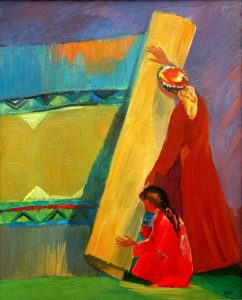 Chiy*. Oil on canvas, 80.7×64.3, 1994
Chiy*. Oil on canvas, 80.7×64.3, 1994
Mom and daughter, moving carefully from right to left, roll up the wall carpet. Rolling down the wall. Mom in a colorful scarf, in a dress of red ocher, daughter in red and she has pigtails. Mom works standing up, daughter sat down next to him. Helps, supports. Rolling up the decor! Behind which is a blank wall … or a deep sky? … The reverse side of the already folded part turns yellow. A diagonal suprematist rectangle divides the composition into two parts. For what was and what will be. Beauty is rolling! It looks like a fake decoration. Beauty is gone! Unnecessary. The spirit is gone – there is a composition that few people understand. What’s next? Space of opportunity? Or a depressing emptiness? Everyone looks at the artist, but he has nothing to offer …. But strange! His picture is optimistic! Colors are bright and clean, lines are peppy and strong. He admires the harmony of yellow and violet, cobalt green and cinnabar, red ocher and kraplak**. transparency and density. So there is faith that everything will be fine! And in place of the old, a new one will come, just as worthy. It sounds like a testament! Do not despair, there is a time to unfold beauty and there is a time to turn back, and between these events there is life…. And creativity! And do not be afraid to be left alone, “without protection against the action of the sudden and hostile forces of our beautiful and furious world”***
* Chiy – tall stiff steppe grass, the stems of which Kyrgyz craftswomen use to make mats
** kraplak – bright red paint (a combination of alizarin and purpurin with basic aluminum salts)
*** Quote from Andrey Platonov’s book “In a beautiful and furious world”
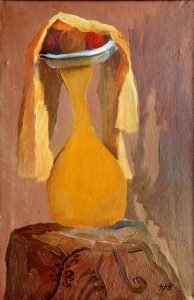 Still life with pumpkin. Oil on canvas, 47.5×35.5, 1994
Still life with pumpkin. Oil on canvas, 47.5×35.5, 1994
This still life and “Still Life with Pink Drapery” should be viewed together as a diptych*. Both paintings were made in the same year, as variations on the same theme. The composition is repeated: a jug of pumpkin stands vertically on a draped stand, a plate of fruit is on the jug. The main items remain, a towel has been added to them. Everything is repeated, but this is a completely different work, this is a completely different mood. The vertical remains – the harmony of dynamics, the balancing quintessence of the South! “Still life with pink drapery” is summer, and this one is autumn. Autumn is a muted yellow-brown color, and the fruits are large – final! Which one was made before? Unknown. The summer still life is a girl, and in the fall a married woman. The girl is wearing a playful hat. And on the woman – a heavier burden, she covered herself with a scarf … Probably, the artist in an era of change, in indecision, continued variations of the theme he had found. And he was waiting for Galatea ** to come to life and call to abstract distances, ideal shores. I wanted to keep up with the times! So I didn’t decide. And he did the right thing. More painting Kyrgyz yzstan was waiting only for postmodern compilations***, self-repetitions and rare successes. We will call them a continuation of the Southern School of Soviet Major Modernism!
*Diptych – as an artistic term, a diptych is a work of art consisting of two parts or panels that together create a single work of art (triptych – three parts, polyptych – many).
*** Galatea is a female name. In ancient Greek mythology, it was worn by:
Galatea – Nereid, daughter of Nereus and Dorida, who rejected Polyphemus; personification of a calm sea.
Galatea is a beautiful statue created by the sculptor Pygmalion and brought to life at his prayers by the goddess Aphrodite. This image of an animated statue fell in love with playwrights, poets and artists.
** Compilation – a book or article, essay, compiled on the basis of other works, and not an independent study of primary sources.
 Still life with pink drapery. Canvas, oil, 48×34, 1994
Still life with pink drapery. Canvas, oil, 48×34, 1994
The ash-pink drapery is drawn in reverse perspective. On it stands a jug of orange gourd. The vessel resembles a woman who carries a burden on her head. And the green-blue plate looks at us with its only eye. And the dark crimson pupil attracts all our attention. Only lines and color, and the image of objects is fixed in our minds forever. The golden drapery patterns suggest what the author was looking for in objects – a pattern, an abstraction! Plastic peeped in reality, but the genius composed their characters. The “patterns” of the background also work for the master: the light side actively forms the texture of the wall, and the shadow side sinks and organizes the depth of space …. It’s all scenic! And in the depths? In the context? In context: we are now the Kyrgyz Republic, we have the first president and already have our own currency! The era of change has begun. Change what? Appearance? Is it possible to change inside? Is it possible to move to pure abstraction? It would be logical! There is nothing left of reality! The pitcher does not look like a pumpkin, and the pumpkin does not look like itself? And a plate is not a plate either. I am generally silent about the stand. A little more and this dubious connection with reality will not be needed. But something gets in the way. Traditions? Soviet? Southern? Interferes with the phenomenon! From the point of view of the West, it is not completed and secondary. And we think it did! It became unique in the fight against far-fetched ideology and stubborn bosses. We’ll call it the Southern School of Soviet Major Modernism!
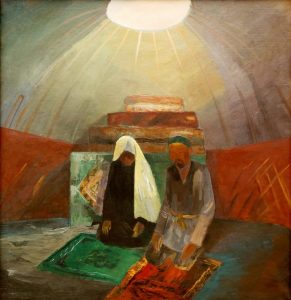 Prayer. Oil on canvas, 120.7×114.3, 1991
Prayer. Oil on canvas, 120.7×114.3, 1991
Here is what the well-known art historian of Kyrgyzstan Olga Popova writes about the stages of the artist’s work: “The evolution of his (Asrankulov Aman) thematic and formative searches can be divided into two sharply different stages: the Soviet period, when he was interested in social problems…; and the period of the 90s, when he showed himself as a philosophically minded artist…”.
Today we can clarify: earlier the artist was interested in social and philosophical problems, understood by him in the Soviet way, and after the collapse of the USSR, he directly turned to religious topics. To topics new, unknown. The two in the yurt knelt on prayer rugs. Ordinary people: an old man in all gray and an old woman in a black dress and a white scarf draped over her head. Alone. Left alone in a tragedy? No hint details. Strange: there is not a single detail of Soviet life. As if those 70 years never happened! But here’s the catch: in Islam, men and women don’t pray in the same row. Did the Muslims of Soviet Kyrgyzstan know this? Or did they not consider it important? The main thing was to keep the faith…. The yurt is a house of prayer, light pours out like God’s grace through the tunduk (the top opening of the yurt). The vertical is clearly visible – light, figures, rugs. The horizontal is formed by a fence. The vertical is supported by a pyramid of a huge green chest and a stack of blankets. Vertical and horizontal form a cross! No need to look for characters here! But the artist cannot help looking for symbols! The artist sees how well the yurt serves for prayer. Top lighting! There are no windows and a mood of detachment from the outside world is created. There are no walls, we see a sphere! Universe! Teniri! Isn’t this mystical? And is it allowed? These are new sensations, and whether they are religious or mystical – this still needs to be understood. In the meantime: the painter and philosopher for all time, as it was, and left! The main moral support is the universe above your head and faith in your soul!
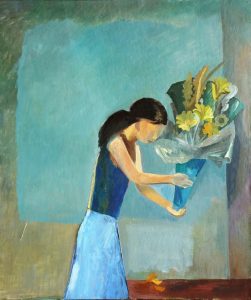 Paper flowers. Oil on canvas, 99.5×85.5, 1991
Paper flowers. Oil on canvas, 99.5×85.5, 1991
The blue square on the wall is fresh plaster? Or is this window “blinded”? It became unnecessary and was laid down. It has become dangerous: through its eyes one can see all the meanness of our times. Better not to see, better to daydream, go blind, fall asleep. As Michelangelo Buonarroti wrote, “… in this criminal and shameful age / Not to live, not to feel is an enviable lot … / It is gratifying to sleep, it is more gratifying to be a stone.” And the girl also sleeps (she laid her eyes shut, sealed her eyes), fell ill with the diseases of her era, and lovingly carries artificial, invented beauty, and, like a blind woman, does not notice natural beauty (a few inconspicuous, withered leaves below). This behavior attracts the attention of the author of his unnaturalness: he does not understand a world where even flowers are paper. However this is not a reason for tedious morality: this circumstance inspires the artist to search for harmony! Modern harmony – mechanical movements and artificial colors; where the accent is warm leaves on brown earth, and cold shades dominate, coming from indifferent paper. Successful searches! But what about social art? We need activism – not aestheticism! … But how carefully the girl treats paper flowers – as if they were alive…
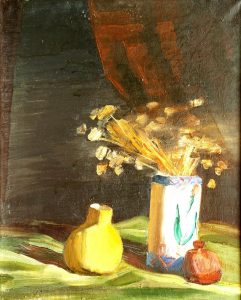 Still life with paper vase. Oil on canvas, 60.7×49.5, 1990
Still life with paper vase. Oil on canvas, 60.7×49.5, 1990
Wildflowers, dried tansy and yarrow stand in a paper vase. Most likely, a tin can was adapted under the vase, pasted over with hand-painted paper. Or used, which has become unnecessary, drawing. Part of the inscription is visible, probably the word “Congratulations”, and a red tulip. Another vase is carved from a yellow pumpkin. Near the burgundy fruit – pomegranate. All three settled down on a crumpled green drapery, moved to the right corner. The still life is illuminated by bright sunlight and the dark interior of the room on the right also becomes part of the composition… At the end of the era, the artist turns to work from nature and is looking for something new. The images are strange. A paper vase is a symbol of time! The theatricality inherent in the master breaks through: sunlight becomes the light of spotlights; the drapery turns into a velvet theatrical curtain. An ominous emptiness reigns in the depths of the stage, and characters are talking on the stage. The yellow merchant, the owner of the container, brought water to the celebration. The little burgundy knight is ready to risk his delicious beans. And the indifferent tin paper keeps the raging crowd of the thirsty at an unattainable height. Thirsty, excited, look from above into the neck of the vessel and ask to be given a quick drink.
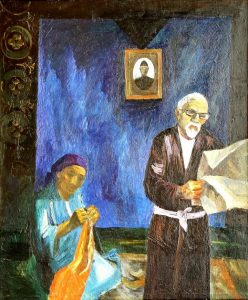 Portrait in the interior. Oil on canvas, 117×100, 1982-1987
Portrait in the interior. Oil on canvas, 117×100, 1982-1987
A white-headed, white-bearded old man in a black chapan tied with a white scarf, armed with glasses, is looking through a newspaper while standing. An old woman is sitting on the floor beside her, knitting a red sweater… The old men bowed their heads sadly to one side. Behind them, on the wall carpet, tush-kiyiz, hangs in an oval frame a portrait of a young man in a soldier’s cap. The result was a portrait of the family in the interior. Old parents and a photo of their son. A portrait of a son who died in Afghanistan? Where is the black frame? He may be serving in Afghanistan! Then it is clear: why the old father looks through the newspaper so carefully, looking for military news. It is clear to whom the old mother knits a red sweater. Primitivist drawing, somewhat caricatured, dark disturbing coloring. The wretchedness of the environment is not hidden. Portraits on a blue square in a black border with national patterns. There are carpets and blankets on the floor. And that’s it. A portrait of the senseless Afghan war! The old people have learned to hide hidden pain, they are used to being distracted from heavy thoughts by daily worries, traditions, and rituals. And through the touch of irony, through the indifferent form, a sharp pity breaks through.
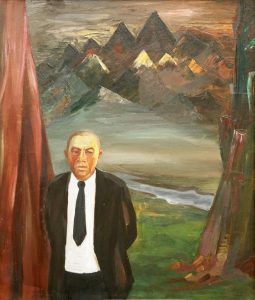 Portrait of M. Ryskulov. Oil on canvas, 114.8×97.3, 1986
Portrait of M. Ryskulov. Oil on canvas, 114.8×97.3, 1986
Muratbek Ryskulov (1909-1974) – Soviet, Kyrgyz theater and film actor. People’s Artist of the USSR (1958). Born into a poor peasant family. In 1937 he graduated from the studio at the Kyrgyz Music and Drama Theater (now the Opera and Ballet Theatre). Since 1941, the actor of the Kyrgyz Drama Theater. Brilliantly played the role of Bakai in the film directed by Tolomush Okeyev “Bakai’s Pasture”. At the same level, he played the role of Zhantai in the film directed by Melis Ubukeev “Ak-Mөөr”. Deputy of the Supreme Soviet of the Kyrgyz SSR of the 5th-8th convocations …. The portrait was created from memory and imagination. An artist is in the foreground, a theatrical curtain opens in the back, and there is Kyrgyzstan! River, valley, mountains, snowy peaks. According to the content, everything is correct, thoughtful, pathetic! But somehow it’s all written! The artist is not young, serious, stooping, tired, not romantic, down to earth. Not an elegant black suit, tie, white shirt. The artist does not flatter his character. Doesn’t flatter the landscape either. Gray skies, dark mountains, dirty gray colors. In the corner, painted backdrops are rolled up, which have become unnecessary. The idea of overcoming convention? What is this primitive form about? Maybe this is what Anna Akhmatova had in mind when she wrote: “If only you knew from what rubbish / Poems grow without shame, / Like a yellow dandelion near the fence, / Like burdock and quinoa” … Perhaps with a gloomy color the artist wanted to show us the eternal dissatisfaction of the genius with himself and his work. Or the fact that great actors – the same simple people – are not celestials *. Fullness! You won’t fool the tradesman! He sees – the artist scoffs. And today such an accusation will sound appropriate. And in the 1980s, the townspeople kept quiet. They knew it was none of their business. It turns out that, breaking away from the “people” (philistines), art becomes truly folk? … The appearance of such a portrait in modern times is impossible. The aesthetics of the subconscious, mysterious, unsaid enters into open conflict with the official aesthetics of the clear, understandable, self-satisfied!
*mythol. in a number of religions – an inhabitant of the sky, b ozhestvo. In a figurative ironic sense – a representative of the upper strata of society, the elite
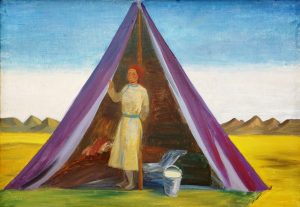 In Mongolia. Oil on canvas, 70×98, 1986
In Mongolia. Oil on canvas, 70×98, 1986
This is the impression of what he saw on a creative business trip. The author did not work from nature – he recorded his observations in pictorial plasticity. The purple tent is most likely MAYKHAN, a nomadic dwelling of the Mongols. The design is very simple: in the middle there is a pole and from it in different directions there are stretch marks made of dense fabric. It turns out an equilateral triangle. In the center of the entrance – the canopy is thrown back on both sides. Inside, a girl in national clothes leaned on a pole. On the right is a bucket with koumiss, mare’s milk. The triangle dominates, behind it are the horizontals – the blue sky, the yellow steppe, the mountains stretched out into a narrow chain of brown triangles. A picture of an unfamiliar and so familiar life. There is koumiss, but where is chanach? A container for storing and whipping koumiss? You don’t understand another life, or you think you don’t understand, you’re afraid to make a mistake. And you can only talk about composition…. Symmetry is the ideal structure of the universe. And man made a compositional device out of this structure. The pathetic, imperial idea of a single center. And the man in the triangle – the basis of all that exists, stands on the ground and rushes to the sky … A formal analysis of the modernist composition is not suitable for the interpretation of painting. It always seems that there is something deeper than appearances…. There is a girl in a triangle in the middle of a clear and bright world. In the brown triangle there is another world: a human dwelling with its simple belongings. And the girl is waiting for someone who will share this dark, frightening, unknown universe with her.
 View of Sulaiman Mountain at night. Oil on canvas, 90×70, 1986
View of Sulaiman Mountain at night. Oil on canvas, 90×70, 1986
The picture consists of two worlds. Below is a small courtyard, and above – space! A clear line separates the worlds. It is formed by: the roof of the house, the top of the canopy, the wall of the duval. The courtyard is illuminated by the cold light of the moon and the warm light from the window. Orange seems to be poured onto the ground, covering both the horse and the person. From above, a tree and strange shadows on a huge, ocean-like space. A small silhouette of the sacred mountain is recognizable in the distance. Above – a dark blue night sky, a full moon and wavy clouds …. Two worlds: small and large, near and far, transient and eternal. An immanent theme of any landscape. The upper world is fantastic, mysterious, mysterious… and dangerous. The lower one hides from him behind the fence, preoccupied with his little worries, does not raise his head and does not see the grandiose splendor from above. And to which world does the tree belong? Is it in the middle? It seems that the canvas is “crushed” by a thick layer of paint. But the author does not need transparent prettiness – the geometric concept is important to him! These are two different worlds, and they will never meet. And both together are of interest only to the artist. He sees the horse turn its head and look at the man expectantly. The man does not look at her – he looks at his feet so as not to stumble. And a person does not look up, does not waste time. He carries a bunch of grass for the horse. Yes! Indeed so! Only two things fill the soul of a Kyrgyz! You need to feed the cattle and know that there is a starry sky above your head. He doesn’t need to look at them! He is directly related to them. He knows how the upper world gives strength to the lower one so that it continues to live and surprises the sky with its little worries.
 Haymaking in the mountains. Oil on canvas, 79×114
Haymaking in the mountains. Oil on canvas, 79×114
Magnificent game of contrasts of the left and right sides. To the left is the illuminated edge of the haystack. A man rests in its shade, takes off his shirt, makes himself a canopy and admires the landscape. On the right is an illuminated figure of a woman working with a pitchfork. Behind her is a second haystack, extending beyond the edge of the picture. The second is in the shadow of the first. The man rests and the woman works. Did the artist want to show gender inequality? Hardly. Women’s activity in collective farm work? May be. Did women trust their superiors more and were they more disciplined? It may very well be. Can a woman complete her individual order? Increased obligations? Or does not want to sit next to a man? Wants to move, the working day is not over yet. It seems that the artist is not interested. It is busy with interesting alternations: light on dark, dark on light. Hay is harvested from above, in the mountains. Two stacks – a parting curtain that extends beyond the edges of the picture. Down on the stage is a mountain valley. In front of the curtain is a woman in a blue dress and headscarf. She is convex in the light, material. The man behind the curtain is dark and monotonous. She is the blue mountains and the sky, he is the earth and the dark village. She is a hard worker and activist! He is a contemplative and net. Two and production. A frequent theme in the painting of Kyrgyzstan. But there are no lyrics typical for the 60s and 70s. There are just two here. They interact like objects of composition, but there is no spiritual unity between them. Not Jamilya and Daniyar. And they never will. They ended up here together, because on this summer day, at this job, on this hill, they were brought together by a collective farm. Collective alienation is a modernist theme!
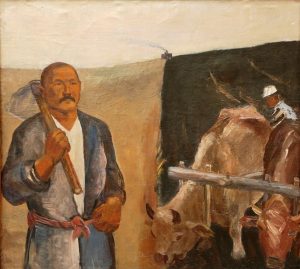 Spring. The first chairman of the collective farm “Ortho-Asia” in the south of Kyrgyzstan K. Suranbaev
Spring. The first chairman of the collective farm “Ortho-Asia” in the south of Kyrgyzstan K. Suranbaev
Oil on canvas, 78.5×86, 1986, KNMI Suranbaev Kambaraly (1894-1953) was born in the village of “Orto-Asia” of the Suzak region, in 1937-50s – a deputy of the Supreme Soviet of the USSR. Chairman of the Jalal-Abad Regional Executive Committee (1939). In 1928-31 he was the organizer of Komsomol and party cells in the Suzak region. In 1931 he organized a collective farm “Ortho Asia”, was the chairman of the board. Honored Worker of Agriculture of the Kyrgyz SSR. He was awarded two Orders of Lenin, two Orders of the Red Banner of Labor, the Order of the Badge of Honor …. The picture of the full support of the policy of the party and government in the field of agriculture! But the artist did not give up formal principles. The manner of execution is reminiscent of the style of social primitivism of the 30s… The earth is divided in half into black and ocher*. Black is human, already plowed, ocher is natural, untouched. A tractor drives in the middle, smokes in the distance. Field, sky, oxen, people – shades of yellow earth. A “black square” is approaching them. It was “drawn” by a tractor. Are oxen harnessed to the plow necessary? In the era of collectivization and mechanization, they were left idle. Do you need a person with a catman? Probably needed. We need an owner who will manually correct the imperfections of imperfect equipment! We need a chairman! The convinced figure of the chairman with a strong-willed face, and in contrast – the drooping figure of an ordinary collective farmer. A few became order bearers, Stalin’s falcons! And the majority remained indifferent mass. There will be many orders – there will be no labor productivity. And the chairman is not the owner, the chairman is an official. The author has shown that he can paint not only decadent pictures. He is capable of complex work, ambiguous, visionary.
* Ocher is a natural pigment consisting of iron oxide hydrate mixed with clay. Ocher color – from light yellow to brown-yellow and dark yellow.
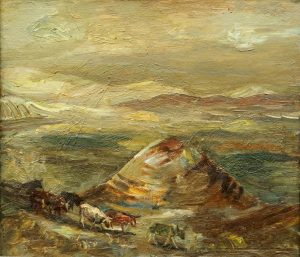 The return of the herd. Oil on canvas, 60×70, 1985
The return of the herd. Oil on canvas, 60×70, 1985
The cows return from the pasture in the evening. The shepherd is not visible. Pets themselves lined up in a chain and obediently wander along the usual path to the stall. White, black, grey, brown, red. This monotonous movement is somewhat diversified by someone who looks like a black bull. He appears behind the herd, crawling out of the shadows. A mixture of light ocher, red, black and white forms a variety of shades of gray-green color. You can’t see the village, the windows don’t light up friendly, there are no cozy trees, the owners don’t greet you. Around emptiness. The artist is not interested in a banal production theme. He created a symbol of a closed world with its center around which everything revolves. The road is twisting, cows are circling. In the center is a hill that looks like a yurt or a volcano. Above is a tunduk or a reddening crater, from which smoke will soon come out. This is our common world: we all go in circles. From home to work, from work to home. And only a bright sky, peaceful clouds, eternal mountains in the distance give us hope that there are more meaningful movements. Heaven as a hope for a higher mind! What a bold idea on the eve of Perestroika and Glasnost in the USSR. A small, inconspicuous work, one of the best works of Kyrgyz pictorial modernism. The content is not socialist, the form is not realistic. A unique variation of the general mood of decline, sobering, repentance… no need.
<= ISSUE 10. PART 2 TO BE CONTINUED
Telegram-channel in Kyrgyz & Russian:
Санжарбек Данияровдун коомдук фонду
Фонд Санжарбека Даниярова
Subscribe if interested




